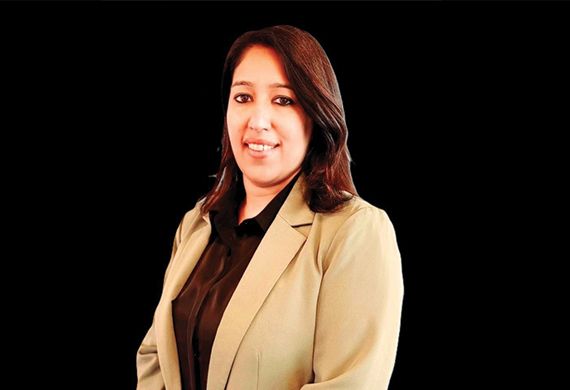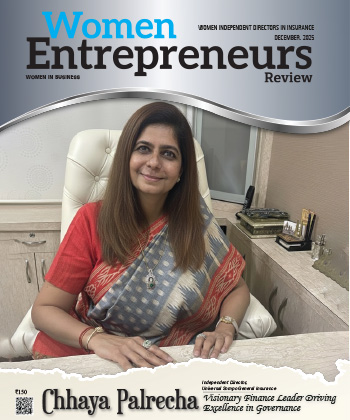
Leading Global HR Transformation Through Tech & Bold Leadership
By: Harmeet Kaur, Head- Global People Services, Ericsson
Harmeet Kaur is a results-driven HR leader with 20+ years of global experience in shaping and executing HR strategy and operations. At Ericsson she leads a 500+ team across 130 countries, overseeing recruitment, rewards, international mobility, payroll, talent, L&D and people analytics, aligning HR strategy with business goals to drive transformation and high-performance cultures.
In an engaging interaction with Women Entrepreneurs Review Magazine, Harmeet shares her insights on leading global HR transformations by leveraging technology. Sharing sharp leadership takes, she explains how inclusivity, agile change, and bold leadership can reshape employee experiences, empower teams, and enable women leaders to drive large-scale, future-ready organizational change.
To know more about tech enabled HR transformations being led by women leaders, read the following interview featuring Harmeet Kaur.
In leading global HR transformations, which tech integrations have significantly improved employee experience? How can other organizations ensure these tools are culturally and operationally inclusive?
From my experience leading global HR transformations, the most impactful tech integrations are those that simplify the complex ecosystem of data, mapping, analysis, and end-to-end workflows by embedding them seamlessly within HR processes. In many organizations, we operate with a mix of core systems and specialized solutions, which often leads to fragmented data and disjointed workflows. The real differentiator is how technology can unify and streamline this data-process web to create a frictionless experience for the end user.
Agentic AI now opens up opportunities to address both repetitive and unique scenarios, effectively 'dumbing down' overly complex systems into intuitive, context-aware interfaces, making them significantly more accessible.
For true cultural and operational inclusivity, tools should be designed to feel as simple and engaging as social media or e-commerce platforms—self-service by design and requiring little to no formal training or quick reference guides. This focus on simplicity and intuitiveness fosters a 'pull factor,' where employees naturally adopt and engage with these tools, rather than needing them pushed through mandates. The ultimate goal is to create workplace technologies that people want to use because they make their work lives easier and more connected.
You’ve standardized HR processes globally. What key challenges did you face aligning tech platforms across diverse markets? What advice would you give to leaders managing similar scale?
Aligning global HR processes using technology platforms is a balancing act between standardization and necessary localization. Our ambition should be to create unified processes and systems that offer employees and managers seamless experience across countries.
However, we must also respect local statutory requirements and business-specific needs for the right reasons. The key is to create a flexible digital experience that supports employees and HR without the need to overly monitor both the system and the employees.
Another major challenge is futureproofing both processes and digital interfaces in the face of rapid change. This means embedding a continuous cycle of review, refresh, and adoption into the way we manage HR systems, ensuring they remain relevant over time.
To enable this, leaders must embrace change management as an ongoing business-as-usual (BAU) capability, not just an occasional project-based activity. This proactive approach keeps the organization adaptable, resilient, and ready for the future.
When managing large-scale tech-enabled HR initiatives, how did you ensure that employees felt engaged and empowered rather than overwhelmed by process and system changes?
In managing large-scale tech-HR initiatives, I’ve found that adopting a sprint-based, agile approach has been crucial. I believe in the 'fail fast and adapt' mindset — starting with smaller pilots and shorter sprints so that we can test changes, gather feedback, and iterate quickly. This way, employees aren’t asked to adapt to massive shifts all at once but rather feel part of a gradual and inclusive transformation.
Co-creation with business is another key pillar for me. We actively involve employees in generating ideas and shaping solutions that address their real needs. We make sure we share stories internally and externally — both successes and learnings — so that we build transparency and trust.
To drive change from within, we give ownership to our employees by involving them in global projects and applauding them as ‘Transformation Champions’ and ‘Change Makers’, who act as role models and catalysts.
Upskilling is central to our philosophy — ensuring everyone feels confident in embracing new tools and methods. And to keep energy high, we run frequent Innovation Challenges with our employees, fostering a culture where ownership of technology replaces fear of it.
This combination of agility, co-creation, storytelling, empowerment, and continuous learning helps employees feel engaged, empowered, and genuinely excited about the journey, rather than overwhelmed by it.
Could you share an example where tech integration significantly improved a key HR process. How did it impact the overall business performance?
In my experience, one of the most impactful tech integrations we've implemented was moving from fragmented helpdesks to a single, fully Integrated Helpdesk for employees—covering HR, finance, and sourcing needs all in one place. Our driving focus was on automating end-user transactions and making them truly self-service. This shift meant employees no longer needed to navigate multiple platforms or wait for manual support for routine requests.
Our bigger ambition has always been to automate the entire spectrum of queries and tasks across these domains. Our ambition is to automate close to 80% of ‘How To’ queries, of which 50% is already achieved & we continue to improve this to drive real time support & self-service. This has resulted in faster turnaround times, fewer manual interventions, and overall improved employee satisfaction.
With agentic automation capabilities, we are taking steps to map our straight-line processes & tasks as well as low to medium complex tasks to make them fully automated for real time support to employees & managers.
Leading a team of over 500 HR professionals, what strategies helped you align global transformation goals with individual team motivations across multiple countries and time zones?
Leading a diverse team of HR professionals, I’ve come to understand that our global transformation goals truly take flight when we co-create them alongside our employees and embrace shared ownership.
We partnered directly with employees across functions to design transformation initiatives that resonated with their day-to-day challenges and ambitions. To deepen engagement, we launched innovation challenges open to everyone, HR, IT and beyond—inviting fresh perspectives from all corners of the organization.
The most powerful way to ignite enthusiasm is to crowdsource ideas from the ground up, giving every employee a voice. We invested heavily in upskilling, ensuring team members were prepared to adopt new practices, and we identified ‘transformation champions’ and ‘change-makers’ within HR to model innovative behaviors.
Ongoing story-sharing on companywide channels and in our internal social streams kept motivation high, while unit-wide events like our ‘Grow Talks’ showcased cutting-edge technologies and celebrated innovative projects. One of our proudest achievements was making AI tool usage a core habit, not an optional extra.
By aligning organizational objectives with individual growth paths, we’ve stayed future ready as a cohesive, employee-centered team.
Based on your transformation journey, what is the one most valuable piece of advice you would give to women leaders aiming to drive large-scale change in a technology-driven environment?
If I had to share one valuable piece of advice from my transformation journey with women leaders aiming to drive large-scale change in a technology-driven environment, it would be this: think big, because the challenge often starts with smaller ambition.
I’ve learned that we must believe deeply in the art of the possible — what technology can achieve today is often far beyond what we could have imagined just a few years ago. For example, we are all impressed by ChatGPT today, but not too long ago; this level of conversational AI seemed almost unthinkable.
I encourage every leader to raise the bar and change the game with higher leadership standards — because when you expect more from yourself and your teams, you inspire groundbreaking outcomes. Along the way, be relentless about upskilling. I truly believe that we must not fear technology but embrace it. The real fear for individuals should not be technology but a workforce that is smart at embracing and adapting to technology.
So, embrace bold thinking, push boundaries, and never stop learning — that’s how you lead transformation at scale in a fast-changing technological world.
Most Viewed
- 1 Women's Health Startup HerMD Closing Doors Amid Industry Challenges
- 2 5 Famous Women in Indian Armed Forces
- 3 Saudi Women No longer Require Male Permission for Clothing Choices, says Prince MbS
- 4 Kolkata Medtech Startup Innovodigm Raises Rs 5.5 Crore Seed Funding Led by IAN Group
- 5 Yamunanagar's Kashish Kalra Honoured after Securing 111th Rank in UPSC Civil Services Exam
- 6 Madurai Appoints Its First Woman Corporation Head
- 7 IAS Vijayalakshmi Bidari Appointed as the new Nagpur Divisional Commissioner
- 8 American Entrepreneur Lucy Guo Overtakes T Swift to become Youngest Female Billionaire
- 9 ICC Women's World Cup 2025 Trophy Showcased at Indore's Holkar Stadium
- 10 Aparna Saxena's Beauty Venture AntiNorm Launches in India
- 11 Vidya Nataraj Co-Founded BlueStone Jewellery & Lifestyle files IPO
- 12 5 Women Freedom Fighters of India
- 13 Dr. G Krishnapriya appointed as CEO for Trichy
- 14 M3M & Sirona Partner to Introduce Menstrual Hygiene Vending Machines in 15 Locations
- 15 Punjab Govt launches SHE Cohort 3.0 Supporting Tech-led Women Startups
- 16 Indian origin Lawyer, Sweena Pannu appointed as the US New Superior Court Judge
- 17 The Aurora Tech Award recognizes 4 Indian Women-led Startups
- 18 Kerala's Republic Day parade featured an all-female tableau
- 19 Manisha Kabbur Becomes Karnataka's First Woman International Karate Coach
- 20 Director K. S. Ravikumar's Daughter Maalica Ravikumar Launches Life Coaching Company 'Evergrowth Academy' for Women
- 21 Leezu's Raises Pre-Seed Funding to Accelerate Growth in Sexual Wellness Industry
- 22 Sattu: Super-easy summer drink for PCOS gut healing
- 23 Swathi Nelabhatla creates Sitha App, India's First Women-Exclusive Gig Platform
- 24 7 Timeless Female Kathak Dancers & their Iconic Legacies
- 25 Meet 7 Iconic Women Architects of Modern India & their Most Impactful Work
- 26 This Woman-led Insuretech Startup is Helping Bridge the Education Financing Gap in India
- 27 Women Leaders Share Lessons Learnt from India Women's WC Win
- 28 5 Enterprising Women Founders Powering Singapore's Tech & Innovation Landscape
- 29 4 Women. 4 Stories. One Vision for Smarter, Stronger Healthcare
- 30 Global Gender Gap Narrows to 68.8%, But Full Equality 123 Years Away: WEF Report 2025
- 31 Changemakers: 7 Women Entrepreneurs Taking the Make in India Movement Forward
- 32 Meet Lucy Guo, The Youngest Self-Made Female Billionaire Disrupting Tech
- 33 How Women are Driving India's Festive Online Shopping Surge






